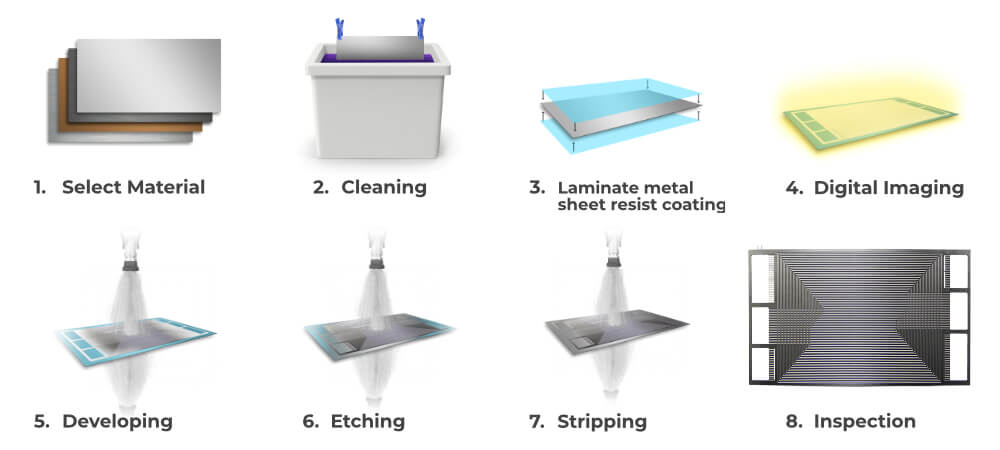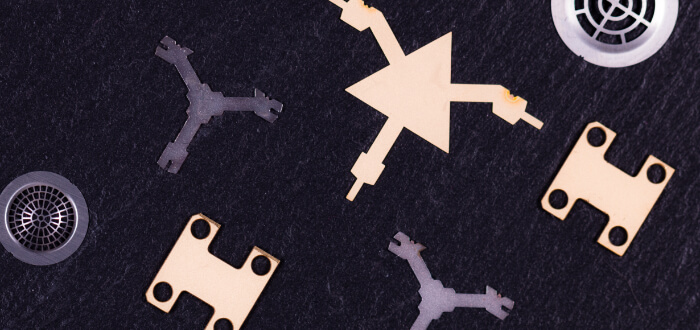As a leader amongst chemical etching companies, we utilize a subtractive manufacturing process that uses corrosive chemicals to etch a desired shape or pattern from sheet metal, creating high-precision components for various applications.
Also known as chemical milling, photochemical machining, or photo etching, it is a versatile and reliable production method based mainly on digital tooling, making it accurate, fast, and cost-effective.
Elcon Precision specializes in advanced chemical etching processes to create complex and highly accurate components from almost any metal.
In this article, we review Elcon's multi-step chemical etching process for metal and talk about some of the advantages and applications of chemical etching.

What Is the Chemical Etching Process for Metal?
Elcon's photochemical etching process has been developed from years of experience in creating high-precision metal parts.
Led by our in-house experts, we consistently produce finer geometries with greater precision than the industry standard.
We utilize multiple etchants (some proprietary) to process a wide variety of materials, including stainless steel, copper, brass, molybdenum, tungsten, titanium, and more.
We fulfill extremely demanding dimensional requirements by tightly controlling every aspect of our machining process.
Our high-precision chemical etching process for metal components is comprised of several steps.
1. Select Material
The chemical etching process starts with selecting the appropriate metal from a wide range of available materials.
Our team works closely with you to ensure the suitable material is chosen depending on the application of the metal parts, as each material has specific functional properties and advantages.
The most commonly used materials for chemical etching include stainless steel, copper and its alloys, nickel (or its alloys), and aluminum.
Do you have a specific metal etching requirement? At Elcon, we have expertise in etching even the most exotic metals, including tungsten, titanium, and molybdenum. Connect with our team to request a quote for chemical etching of a specific material.
2. Laminate Metal Sheet
Once the material is selected, we clean the sheet of metal in a dilute acid solution to remove oils and contaminants. We then laminate the metal sheet with a UV-sensitive dry film photoresist.
The photoresist functions as a mask to prevent the chemical etchant from coming into contact with parts of the metal that need to be retained for the correct shape. The photoresist must be well-bonded to the surface of the metal sheet to ensure an accurate rendition of the desired shape or pattern.
3. Digitally Image Design
A digital image defines the pattern's shape to be etched and a UV laser digital imaging tool transfers the design to the photoresist laminated on the metal sheet. The photoresist film can be applied to both sides of the metal sheet and different designs can be etched on both sides of the metal part.
Once the design is transferred to the metal sheet by the imager, the photoresist is developed which removes the resist that has been exposed. The sheet is now ready to be etched.
We can achieve very fine features and tight tolerances on both sides of the sheet. Actual dimensions and tolerances depend on the material selected and the size and thickness of the metal sheet.
Feature dimensions are typically 1.2x of the metal thickness, and tolerances are usually 10%-15% of the material thickness.
View our Design Guidelines here for dimension and tolerance parameters.
4. Etch Design
The patterned sheet is then moved to our etchers which spray a chemical etchant, usually ferric chloride, simultaneously on both sides of the sheet. The spraying is done at high pressure, etching away all the material not protected by the photoresist.
The chemical etching process works due to the chemical reaction (corrosion) of the etchant on the metal, amplified by time and pressure. After etching the remaining photoresist is removed from the sheet, revealing the final etched components.
Our skilled technicians meticulously control the time and the amount of etchant used for this process. They consider a number of factors, such as the type of metal and the size and thickness of the metal sheet. Perfected etch times guarantee a smooth, burr-free surface of the etched part.
5. All-Encompassing Turnkey Solutions
Once the chemical etching process is complete, we offer a range of value-added services to meet your design specifications and deliver a ready-to-use component.
For example, many applications require two different parts to be joined together to create a ready-to-use metal component. Once a 2D component is photochemically etched, as described above, we can use brazing to join it to another CNC-machined part to form a 3D component.
We use the Haas CNC Milling Machine as well as other CNC tools for machining any special features you may require in the metal components.
We offer electroless or electrolytic plating as a value-added service after the individual parts are etched. We also provide selective plating post-etch.
We specialize in nickel boron and nickel phosphorous electroless plating. Our large-capacity barrels and rack tanks can plate parts as wide as 12 inches and as high as 18 inches.
Request a quote here for our post-etching, value-added services.
6. Review the Final Product
Once the photoresist layer is stripped off (either manually or using a stripping machine), there is a final rinse before the parts are separated from the base sheet.
Elcon offers the option of separating the individual parts etched on each sheet or leaving the sheet with tabs.
We recommend tabbing to allow for faster inspection and safer handling during and after production. For this, a tab is connected to the individual parts so that they stay on the sheet for easy removal after manufacturing is complete.
Refer to our design guidelines for more information about how tabs can be included in your design.
Our quality inspectors review and quality-check each part produced during the chemical metal etching process, ensuring every piece conforms to the dimensional requirements and tolerances specified at the design stage.
Elcon Precision is AS9100D-certified, ISO 9001:2015-certified, ITAR-registered, and RoHS-compliant so you can rely on us for high-quality production.
Chemical Etching Applications
The chemical etching process is used for high-precision components across many industries and applications.
We can deliver quick turnaround for prototypes and ensure precision in small- to high-volume production runs for mission-critical applications.
Here are some of the applications in which our chemically etched parts are used:
Control Grids
We specialize in manufacturing control grids for traveling wave tubes (TWT) and other applications. In fact, we invented the process of etching and forming 3D grids over 30 years ago.
Traveling wave tubes are microwave amplifiers that use hemispherical grids to control and focus electron beams. TWTs are used in many applications, including microwave receivers, communication satellites, radar, and threat detection and deterrence.
Bipolar or Fuel Cell Plates
We manufacture photochemically etched custom bipolar flow field plates or fuel cell plates etched with corrugated channels. Our advanced chemical etching process allows us to deliver at fast lead times and gives us the flexibility to create complex, high-performance bipolar plates.
Custom Meshes & Screens
We produce etched mesh screens for use in a wide range of applications, from medical devices and particle filters to current collectors. Our chemical etching process produces meshes and screens with more complex geometry, higher accuracy, and greater integrity than traditional woven meshes.
From aerospace and defense to biomedical and renewable energy, we work with partners across industries to take your product from design and concept to prototyping through full production with fast and reliable delivery. Examples include:
- Biomedical: Oncology, orthopedic surgery, surgical devices
- Defense & Aerospace: Radar, IR detection, X-Ray, microwave, border protection
- Electronics and Commercial: Semiconductor, lidar, communication, analytical instruments
- Renewable Energy: Energy storage, fuel cells, electrolyzers
Request a quote here to see how we can fulfill your requirements for any industry or application.
The Advantages of Chemical Etching for Metal
Chemical etching has many benefits—it is particularly effective when you need intricate shapes or patterns or thin metal parts of complex designs.
Since there is no hard tooling, it is more cost effective than traditional stamping methods or alternative techniques like laser cutting.
As there is no force or heat stress induced on the metal, the chemical metal etching process results in stress-free, burr-free surfaces that don't require additional finishing.
As there is no hard tooling or stress on the metal, the original metallurgical properties of the substrate metal are conserved, resulting in high-performing parts.
Besides being fast and repeatable, the chemical etching process is also cost-effective, with shorter lead times than other metal fabrication methods.
Key benefits at a glance:
- Dimensional repeatability
- Burr-free, stress-free parts
- Metallurgical properties preserved
- Design flexibility
- Low-cost tooling
- Fast turnaround
Learn more: Want to learn more about these and other reasons why businesses are increasingly opting for chemical etching for high-quality metal components? Read here!
Surpass Industry Standards With Elcon Precision
Elcon Precision has manufactured the highest-quality precision components and assemblies for over 50 years, specifically designed for mission-critical applications.
We are committed to delivering best-in-class components at quick turnaround times using our advanced chemical etching process for metal parts.

